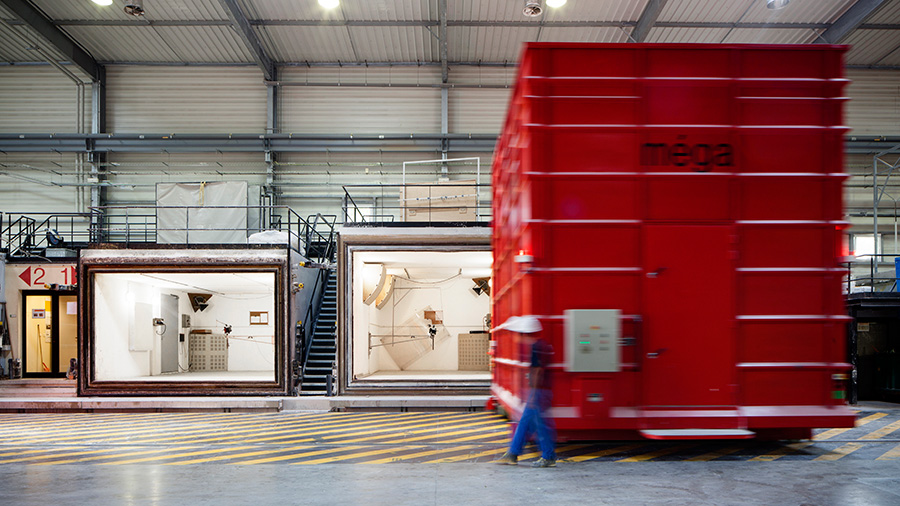Acoustic comfort, acoustic performance, regulatory compliance: meeting these requirements means determining the acoustic characteristics of materials and components in structures (buildings, urban and transportation infrastructure). The CSTB performs measurements at its European acoustics laboratory using services that are COFRAC No. 1-0305 accredited (scope available on www.cofrac.fr). The European Laboratory of Building Acoustics (LABE) in Marne-la-Vallée has nine test benches located on 2000 sq m. Special test benches in Grenoble complement these. The CSTB may also use simulation software to deepen the analyses. It guides stakeholders in designing and tailoring many kinds of systems, with quick turnarounds and in accordance with international standards (NF, EN, ISO and ASTM).

The CSTB performs tests on solid, viscous and porous materials to study their acoustic properties. It also analyzes the acoustic quality of a wide range of products, systems and equipment. The data generated from testing is essential to guiding innovation, developing quality offers and calculating the contribution of each element to the acoustic performance of structures (buildings, roads, cars, boats, planes, trains).
Sound damping and insulation for airborne sound
Airborne sound refers to street and vehicle noise, shouting, conversations, singing and even noise from TVs, music devices, and so forth. In its acoustics laboratory, the CSTB measures the extent to which a building element attenuates transmission of airborne sound. Tests are performed on horizontal (floors, ceilings, floor coverings, etc.) and vertical (panels, window units, door units, wall coverings, shutter frames, partitions, air inlet, etc.) elements.
For lightweight facades, the CSTB has a test bed unique in France. It measures the contribution of lightweight facades to airborne sound insulation between rooms.
Vibrations at partition wall junctions, light or heavy, can also be tested. Tests can be performed on full-scale models in the laboratory or on-site under specific conditions.
Sound absorption coefficient
To improve health and comfort in buildings and near busy roads, the CSTB is studying sound reverberation. It is measuring the ability of various elements to reduce this phenomenon, whether it is a building component (roof underlayment, coating, insulation, panel, wood structure, etc.) or sound barrier.
Sound diffusion plays an important role in performance halls. To ensure good sound quality, it is particularly useful to know the actual diffusing quality of building materials so that sound diffusers can be used effectively. For this, the CSTB has a test measurement facility in a reverberation room.
Impact sound pressure levels
The CSTB measures the contribution of a floor to reduce impact sound pressure levels when someone walks, children play or chairs are dragged.
Floor coverings (tiles, textile, etc.) and floating screeds placed on a standard floor, heavy or light, can also be tested.
Rainfall sound levels
The CSTB measures the sound levels generated by rain falling on the covering elements of buildings (veranda panels, roofs, skylights, outlets, roof lights) and cars (windshields).
Noise levels emitted from airflow and hydraulic equipment
A building’s acoustic comfort largely depends on the acoustic quality of ventilation and sanitary equipment. For this reason, the CSTB measures the following:
-
Sound power levels generated by airflow equipment
The CSTB measures the noise generated by air vents and ventilation units through which air flows. -
Sound power levels generated by hydraulic equipment
The CSTB measures the noise generated by all types of valves and fittings used in the water distribution facilities of buildings. -
Noise levels generated by wastewater drainage pipes
The CSTB measures structure-borne and airborne noise radiated by drainage pipes (straight, with vertical offsets and in soffits) at different water flow rates (0.5, 1, 2 and 4 liters per second). -
“Noise reduction” related to installation of utility shafts around water pipes
The CSTB performs a specific test that characterizes the performance of utility shafts in reducing the noise generated by drainage pipes.
Water pipes can also be outfitted to pipe insulation systems, flap gates and flanges whose effect on radiated structure-borne and airborne noise can be assessed.
Noise annoyance inside or near buildings exposed to wind
Noise can occur when the wind causes facade elements to whistle (sunblinds, guard rails, corridors) in multistory buildings or complex architecture.
In the initial stages of projects, the CSTB offers its expertise in preventing the occurrence of this type of annoyance using aerodynamic/acoustic analysis and, if necessary, testing in Eiffel wind tunnel.
The CSTB can also intervene when there are problems, thanks to an aeroacoustic detector. Mobile, with a camera and weather station, it records sounds on-site. Experts analyze the phenomenon and offer wind tunnel tests to address problems.
